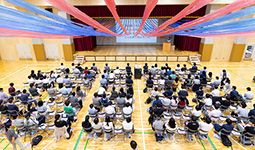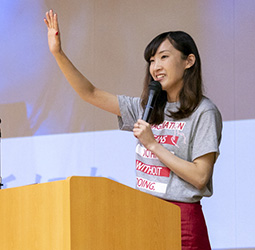Home > Highlighting JAPAN > Highlighting Japan December 2019 > The Power of the Young
Highlighting JAPAN


Creating the Future of Nursing Care
Amid the transition of Japan from an aged society to a super-aged society, the shortage of human resources in nursing care has become an issue. Akimoto Kaai is currently working on a solution to the issue through the development of young human resources and by networking.
In 2025, Japan’s largest population group will be the group aged 75 and over, and before long in 2065 those aged 75 and over will account for one quarter of the total population. With the countdown to this unprecedented super-aged society underway, Akimoto Kaai, CEO of Join for Kaigo INC, is currently working on reforming the nursing care industry together with young colleagues of the same generation with the mission of fulfilling the potential of people through nursing care.
Akimoto has said that she hadn’t intended to major in nursing care in university, but that in a start-up club that she joined when she was a sophomore, she heard a story in which the grandmother of one member of the club developed dementia and became unable to recognize even the face of her grandchildren. This caused her to become interested in the world of dementia and nursing care.”
Then, Akimoto, with the other members, published the free newspaper MAGOKORO on the prevention of dementia, which won the runner-up prize in the nationwide student free newspaper contest. In the last two years of college, she worked a part-time job at a daycare service in a nursing care facility. She then founded Join for Kaigo when she graduated from university in the spring of 2013.
Akimoto says that her two years working at the nursing care service were significant and very fulfilling, but she could identify issues. “The staff working in the industry were so busy that they could only handle the task at hand, and the high turnover rate and the shortage of human resources were also serious issues. I founded the company in order to raise interest in nursing care among young people and to solve these issues.”
According to the Ministry of Health, Labour and Welfare, in 2016 there were about 1.9 million people working in the nursing care industry. It is estimated that about 2.45 million people will be necessary by the end of 2025, and human resources development and employee retention are issues of great significance.
One of Join for Kaigo’s core businesses is consulting on recruiting human resources for companies and municipalities, and providing services to nurture human resources. The company holds seminars for the managers of nursing care facilities on recruiting, fostering, and retaining workers and events in which those involved in nursing care and medical care gather to exchange information and opinions.
Another core business of Join for Kaigo is the management of KAIGO LEADERS. KAIGO LEADERS has six full-time employees and about seventy other members including care workers, doctors, and nurses, mainly providing two human resources development programs for young people in their twenties: KAIGO MY PROJECT and PRESENT. KAIGO MY PROJECT is a three-month workshop in which about twenty participants with a variety of job types, titles and ages exchange opinions, each one of them working on launching a start-up or a business improvement project. PRESENT is a program in which experts from a variety of fields give lectures and based on these lectures, lecturers and participants further discussion, creating a place to see nursing care from a fresh perspective, to develop new ideas, and to build up a network of personal connections.
As many as 3,500 people have participated in KAIGO LEADERS activities to date. Some have launched start-ups while others have worked on the improvement of their workplaces. For example, a doctor who worked for the department of dermatology at a hospital launched a company that provides services for nursing care facilities in which users can easily seek medical consultation using a PC or smartphone. In addition, an employee of a nursing care facility created a workplace where no employees have left for more than one year, through close communication between staff members and the gradual implementation of improvement measures that the staff proposed.
In addition to those who are involved in nursing care, young people and students, who belong to a variety of industries and organizations, also participate in KAIGO LEADERS activities. Speaking of the KAIGO LEADERS vision, Akimoto says, “In 2050, the leaders of the nursing care industry will be the leaders of Japan.” Akimoto explains that the vision contains the hope that having the power to solve the variety of difficult issues globally in nursing care in a super-aged society will surely lead to the power to help Japan improve society as a whole.
KAIGO LEADERS currently has three bases for its activities, in Tokyo, Kansai (established in 2018) and Hokuriku (established in 2018), and will further increase the number to eight from Hokkaido to Kyushu in 2020, with the plan of widening its network of young people interested in nursing care across the country.
It is Akimoto’s challenge, working with the many young people tackling the variety of issues faced by the current aged society, to provide good nursing care and to build good communities and a strong, sustainable society.
© 2009 Cabinet Office, Government of Japan









